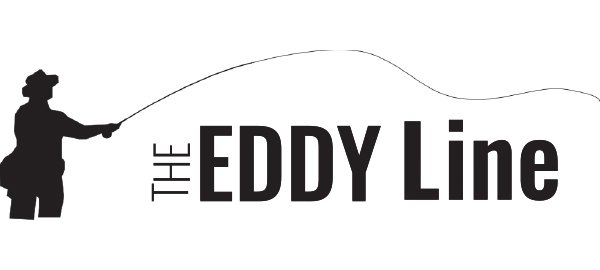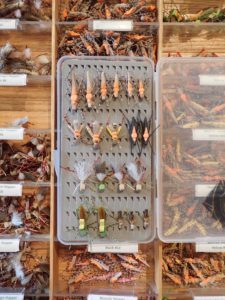Uncategorized
What makes a great grasshopper pattern?
Published
7 years agoon
Posted By
Outlaw Partners
Fish patterns with these traits and have more success
By Patrick Straub EBS Fishing Columnist
On a recent drive home from the river, combines were working the wheat fields—a sure sign that summer’s heat and sun are on the wane. When I was in my 20s, more than two decades ago now, I loathed this time of the angling season. Going back to school was a reminder of fun times passed; low flows in the not-summer-but-not-yet-fall stage had me missing earlier river trips, and I longed for the easier fishing of casting big salmon and stoneflies along the banks in big water to trout who had not seen a fly in weeks.
Late summer and early fall angling doesn’t mean we have forgo our love of big dry flies. Quite to the contrary, anglers in my boat know I cherish the big dry the next several weeks. When the combines turn into the wheat fields is when my angling enthusiasm migrates to a higher level. Hopper-tunities exist.
In Montana, there are eight families of grasshoppers, including four families of crickets. To keep us from getting carried away, let’s simplify even more and just call anything that flies, hops, and lives on the ground but eventually ends up in a trout stream a grasshopper. Here’s some help to choose the best hopper pattern.


Grasshoppers make up a large part of a trout’s diet for the next several weeks. Choose patterns with legs, foam bodies and natural tones such as tan or black. PHOTO COURTESY OF GALLATIN RIVER GUIDES
The legs have it. Nearly all hopper patterns feature legs. From the original Dave’s Hopper and its dyed yellow grizzly hackle, to the more modern hoppers fished today with Sexy Legs and Sili Legs, if you’re fishing a grasshopper pattern without appropriate appendages, you’re not really standing on all your collective angling legs. As long as your hopper has one leg, keep fishing it. Grasshoppers do not like to be on water so they often injure themselves trying to escape once they land on water.
Go big and go foam. In the early 1990s, foam burst onto the angling scene. It had been used sparingly in a few patterns in the ‘70s and ‘80s, but it wasn’t until the Chernobyl Hopper became commonplace that anglers embraced foam. Nearly thirty years later, finding a foamless hopper pattern in your local fly shop is a challenge. Foam allows a large hopper to float for long drifts, and a longer drift means a better chance at catching a fish. Foam flies are less likely to sink, allowing you to twitch a hopper in life-like movements. Hoppers present a big meal to a hungry trout. So fish a big hopper. Big fly…big fish.
Keep color choice simple. Bright green and flashy yellow hoppers look sexy in the fly bins and may seem like a good choice, but many experienced hopper anglers choose natural tones. Grey, tan, pale yellow, light peach and olive will catch more fish than obnoxious colors.
Shape and profile play vital role. Look closely at any natural grasshopper and their body is fatter at the head than at the tail. Choose a hopper pattern that tapers to better represent the real thing. As summer transitions into fall and trout have seen other anglers’ hoppers float by, choose a slimmer profiled hopper and one that will ride lower in the water. My favorite tapered and low-lying hoppers are the Moorish Hopper and the Panty Dropper Hopper.
The eye of the hopper. It’s the thrill of the bite. Natural grasshoppers feature prominent eyes. Consider a trout a predator and a grasshopper its prey; a trout will use the eyes of its prey as confirmation of something live that it might want to eat. Any hopper pattern worth fishing will feature eyes. Trina’s Carnage Hopper has eyes and is often eye-catching to a hungry trout.
Trout are opportunistic feeders and as anglers we also need to be opportunistic when selecting flies to fish. As a young guide in the ‘90s, I worked a lot with Tim Williams. Tim was a legendary guide on the Yellowstone River, who exclusively fished hoppers this time of year. He’d continue fishing his hoppers even if one of the legs had been ruined after a fish had been caught. After watching him release a client’s fat brown trout, I asked him which fly was used.
“The Eileen Hopper.” He said. “My one-legged hopper.”
It took me awhile, but I eventually got the joke when I looked at my client’s fly and saw it too was down to one leg.
Pat Straub is the author of six books, including “The Frugal Fly Fisher,” “Montana On The Fly” and “Everything You Always Wanted to Know About Fly Fishing.” He and his wife own Gallatin River Guides in Big Sky. He also co-owns Montana Fishing Outfitters and the Montana Fishing Guide School.
The Outlaw Partners is a creative marketing, media and events company based in Big Sky, Montana.


Upcoming Events
november, 2024
Event Type :
All
All
Arts
Education
Music
Other
Sports
Event Details
Spanish Classes with World Language InitiativeThese unique, no cost Spanish classes are made possible by the contribution of Yellowstone Club
more
Event Details
Spanish Classes with World Language InitiativeThese unique, no cost Spanish classes are made possible by the contribution of Yellowstone Club Community Foundation (YCCF) and Moonlight Community Foundation (MCF). This class will focus on building a lifelong affinity for world languages and cultures through dynamic and immersive Communicative Language teaching models.
Beginner Class – Mondays and Wednesdays from 5:30-6:30 pm
Intermediate Class – Mondays and Wednesdays from 6:45- 7:45 pm
- Classes begin Oct.7, 2024 and run for 6 weeks
- Class size is limited to 12 students
- Classes are held in Big Sky at the Big Sky Medical Center in the Community Room
For more information or to register follow the link below or at info@wlimt.org.
Time
October 21 (Monday) 5:30 pm - November 27 (Wednesday) 7:45 pm
Location
Big Sky Medical Center - Community Room (2nd Floor)
Big Sky Medical Center - Community Room (2nd Floor)
Event Details
Spanish Classes with World Language InitiativeThese unique, no cost Spanish classes are made possible by the contribution of Yellowstone Club
more
Event Details
Spanish Classes with World Language InitiativeThese unique, no cost Spanish classes are made possible by the contribution of Yellowstone Club Community Foundation (YCCF) and Moonlight Community Foundation (MCF). This class will focus on building a lifelong affinity for world languages and cultures through dynamic and immersive Communicative Language teaching models.
Beginner Class – Mondays and Wednesdays from 5:30-6:30 pm
Intermediate Class – Mondays and Wednesdays from 6:45- 7:45 pm
- Classes begin Oct.7, 2024 and run for 6 weeks
- Class size is limited to 12 students
- Classes are held in Big Sky at the Big Sky Medical Center in the Community Room
For more information or to register follow the link below or at info@wlimt.org.
Time
October 28 (Monday) 5:30 pm - December 4 (Wednesday) 7:45 pm
Location
Big Sky Medical Center - Community Room (2nd Floor)
Big Sky Medical Center - Community Room (2nd Floor)
Event Details
Spanish Classes with World Language InitiativeThese unique, no cost Spanish classes are made possible by the contribution of Yellowstone Club
more
Event Details
Spanish Classes with World Language InitiativeThese unique, no cost Spanish classes are made possible by the contribution of Yellowstone Club Community Foundation (YCCF) and Moonlight Community Foundation (MCF). This class will focus on building a lifelong affinity for world languages and cultures through dynamic and immersive Communicative Language teaching models.
Beginner Class – Mondays and Wednesdays from 5:30-6:30 pm
Intermediate Class – Mondays and Wednesdays from 6:45- 7:45 pm
- Classes begin Oct.7, 2024 and run for 6 weeks
- Class size is limited to 12 students
- Classes are held in Big Sky at the Big Sky Medical Center in the Community Room
For more information or to register follow the link below or at info@wlimt.org.
Time
November 4 (Monday) 5:30 pm - December 11 (Wednesday) 7:45 pm
Location
Big Sky Medical Center - Community Room (2nd Floor)
Big Sky Medical Center - Community Room (2nd Floor)









